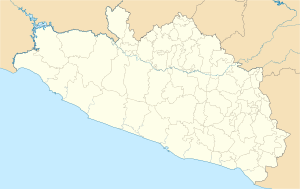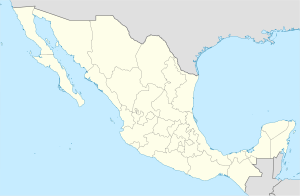Atenango del Río facts for kids
Quick facts for kids
Atenango del Río
|
|
|---|---|
|
Municipal seat and city
|
|
| Country | |
| State | Guerrero |
| Municipality | Atenango del Río |
| Time zone | UTC-6 (Zona Centro) |
Atenango del Río is a city in the southern Mexican state of Guerrero. It is the main town of the Atenango del Río municipality.
What's in a Name? The Origin of Atenango
The name Atenango comes from the Nahuatl language. Some historians say it means "in the wall of water." Others think it means "place of the dam or dike." The "del Río" part was added because the city is located by the Amacuzac River.
Atenango was already a municipality when the state of Guerrero was formed. It used to be part of the state of Mexico.
A Look Back: The History of Atenango
Ancient Times: Before the Spanish Arrived
Long ago, Atenango was part of the Aztec Empire. The people of Atenango had to pay tribute to the Aztecs. This tribute included corn, beans, chili, cotton blankets, and special green stones called "chalchihuitl" (jade).
Colonial Era: Spanish Influence
During the time of Spanish rule, Atenango was important. A person named Hernando Ruiz de Alarcón wrote a book here. It was about the customs of the native people. This book was called "TREATY OF CUSTOMS AND RITES TODAY WE LIVE gentile inhabitants of this place."
Also, three churches were built in the colonial style. You can still see them in Atenango del Río, Comala, and Santiago Gómez-Zacango.
The 1800s: A Time of Change
Atenango played a part in Mexico's fight for independence. General José María Morelos, a hero of the independence movement, came to Atenango. He was trying to cross the Amacuzac River. His soldiers and horses had trouble crossing. Because of this, Morelos ordered the village to be burned. Only one house was left standing.
Later, on November 5, 1815, Morelos was captured near Atenango. He was taken to Atenango. On November 6, soldiers captured with him were shot. The people of Atenango remember these soldiers every year on September 17.
The 1900s: Revolution and Progress
The Mexican Revolution began in the early 1900s. The Mata Figueroa brothers led a peaceful takeover of Atenango on February 26, 1911. They read a statement that said they did not recognize Porfirio Díaz as president. They also asked for fair elections.
To remember this event, President Luis Echeverría Álvarez visited Atenango. He gave land deeds to the people. Important projects were also completed, like a bridge over the Amacuzac River. This bridge connects Atenango to nearby towns and states.
Between the 1940s and 1950s, Atenango lost some land. Several communities became part of Huitzuco.
The Atenango del Río Shield
The shield of Atenango del Río shows what is important to the municipality.
- Center: It shows farming and raising animals. These are important for the local economy. You can see a cornfield, a traditional farming method called tlacolol, and a bull.
- Sky: Pencils in the sky represent education.
- Motto: The words "EDUCATION AND PRODUCE IS PROGRESS" are written on water.
- Nature: An organ cactus and a peak show the warm weather and mountains.
- Seasons: Green plowed land means the rainy season. Yellow land means the dry season.
- River: The river is shaped like a horseshoe. It also shows a symbol from ancient times. This symbol represents the place where native people lived. This area is now called "La Hacienda" or "Atenango the old."
- Animals: Fish in the river show its natural wealth. Two lizards are hidden by the river. They are a species that no longer lives there, but they are part of a local legend.
- Beliefs: Blue water and sky mean hope for the future. A Christian cross on the peak shows the faith of most people.
- Name: The name Atenango is shown in three ways: as a water horseshoe, as an ancient symbol, and in Spanish. The ancient symbol shows how the Aztecs wrote the name.
Exploring Atenango: Geography
Weather and Climate
Atenango has a warm, humid climate. Temperatures usually range from 22°C to 26°C. The rainy season is from June to September. The area gets about 900 to 1,100 mm of rain each year. Winds mostly blow from east to west and from north to south in summer.
Plants and Animals: Major Ecosystems
The main type of forest here is a tropical dry forest. Most trees lose their leaves in the dry season. Common plants include Chupandia (a type of Bursera), Lysiloma demostachys (Tepehuaje), Mexican jacarita (bonnet), impomea (poppy), Agave, and different kinds of cacti.
Taller trees found in the municipality include vultures or caobilla, cacahuananche, tepemesquites, tlamiaguales, azúchiles, guamúchil, and parotas. Along the river, you can find willows, junipers, figs, azúchiles, and atopules.
Natural Resources
Atenango has many natural resources that are not yet used. These include gold, silver, copper, iron, and lead. There is also a lot of clay for pottery, bentonite, and limestone. Bentonite was mined a lot in the 1950s and 1960s.
Land Use
The soils in Atenango come from the Mesozoic era. They are made of sedimentary and igneous rocks. The land is used for growing crops and for raising livestock.
People of Atenango: Demography
Ethnic Groups
In 2000, about 755 people in Atenango were indigenous. This was almost 9% of the total population. Their main languages are Nahuatl and Tlapanec.
The only indigenous tribe in the municipality is Temalac. However, many indigenous families from other towns live in different communities. They moved there looking for better opportunities. In 2005, 571 people in the municipality spoke an indigenous language.
Population Trends
In 2000, the municipality had 8,504 people. There were 4,046 men and 4,458 women. This means women made up about 52.8% of the population. The total population of Atenango del Río municipality is about 0.27% of the entire state of Guerrero.
The population growth rate between 1995 and 2000 was slightly negative. This means the population decreased a little. There were about 21 people living per square kilometer.
Religion
In 2000, most people aged 5 and older in Atenango were Catholic. About 6,273 people practiced the Catholic religion. There were also 1,038 people who followed other religions.
See also
 In Spanish: Atenango del Río para niños
In Spanish: Atenango del Río para niños



